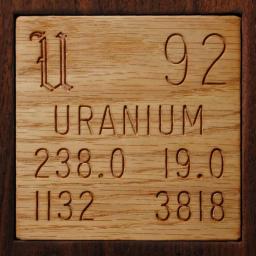 M-735 Tank penetrating munition. M-735 Tank penetrating munition.
Armor piercing projectiles are generally made of depleted uranium, which is uranium metal from which some of the highly radioactive U-235 has been removed. The material is about 20% less radioactive than naturally occurring uranium.
Depleted Uranium is used for several reasons. First, it's very, very dense, so at a given velocity it carries a lot of energy and hence penetrating force. Second, it's very hard, which of course also helps its penetrating effectiveness. Third, it exhibits planar fracturing, which means as it penetrates it sheers at acute angles, effectively self-sharpening while it passes through whatever it's going through. (Thanks to Michael Z. Williamson for this last bit of information.)
Finally, uranium is pyrophoric, which means it reacts chemically with air on impact causing an explosion inside whatever it's managed to penetrate. This is considered superior to, say, a tungsten round that might just go back out the other side.
There's a lot of controversy about the use of depleted uranium munitions, because people are afraid of the environmental effects on the countries that have been shot up with them. If they stayed intact there really wouldn't be much to worry about. But they don't stay intact, they vaporize on impact, and this turns out to have a huge impact on their potential for harm.
The radiation from uranium is largely of a type that does not penetrate skin much past the outer layer of dead cells, and hence is not particularly harmful if it's outside of you. But if you inhale particles of such an alpha emitter, the radiation gets direct access to sensitive cells in the lungs and can do a great deal of damage. Outside the body, alpha emitters are the least hazardous form of radioactive materials, and hence DU rounds, intact, pose little danger to, for example, the people shooting them. But inside the body, they are the most dangerous.
Besides the radioactivity, uranium is also a toxic heavy metal, sort of like mercury. Would you want someone to dump hundreds of tons of mercury in the countryside around you? Probably not. The net effect of the chemical toxicity and radioactivity are such that powdered uranium in and around a battlefield has the potential to cause serious long term medical problems for anyone who comes in contact with it, on both sides of the conflict.
On the other hand, the number of people killed by uranium poisoning is probably significantly smaller than the number killed by whatever difficulty was causing their country to get shot up in the first place. It might be a more efficient use of ones efforts to worry about that than about the uranium dust that's left over. But like land mines, DU is a real problem that the people who clean up the mess of war have to deal with.
A depleted uranium munition is the ultimate sample for a periodic table collection, because of the great difficulty in getting one. Unfortunately, I don't have one: This sample is only a practice round that contains no actual depleted uranium. Sniff. It weighs about 8 pounds, which might sound like a lot, but if it were real, it would be about to two and a half times heavier. (See below for some real depleted uranium, though not a munition.)
Not only that, I have learned that, while many such munitions are made with depleted uranium, a genuine version of this one actually wouldn't be made of depleted uranium either. Reader Steve Pierson reports as followsI have been researching the M-735: The M735 is an armor-piercing, fin-stabilized, discarding-sabot cartridge
with tracer. Other than the primer and the propellant, this cartridge uses no explosives. It is a high-velocity, flat-trajectory cartridge designed for use against armored targets. The projectile section consists of a sub-projectile, a sabot assembly, and a cartridge case. The sub-projectile is constructed of a nickel-steel body that houses a tungsten core with an aluminum windshield and fin assembly. The sabot assembly consists of three 120-degree aluminum sections assembled to the sub-projectile. The cartridge case contains an electrically initiated primer. The color code for the M735 cartridge is a black body with white markings. Its DODIC is C521
I sent you a picture I was able to find, in the picture you can see the tungsten core. I was surprised that it was not one metal. Well, it's all very interesting, and I'm leaving it here under Uranium because I don't move samples, and I think the discussion of the use of depleted uranium in munitions is important, whether I have one or not.
I've included the sound of a tank explosion with the kind permission of geekswithguns.com. I would have recorded one myself, but all my tanks are in the shop right now. If you should happen to have a real depleted uranium round, please consider donating or selling it to me!
Source: Sovietski Catalog
Contributor: Theodore Gray
Acquired: 19 July, 2002
Text Updated: 11 August, 2007
Price: $70
Size: 18"
Purity: 0%
|
| 
|
|